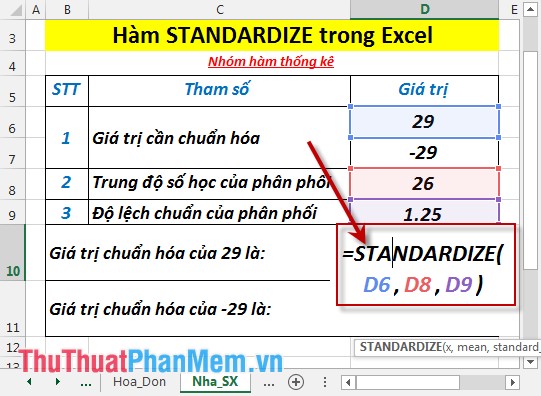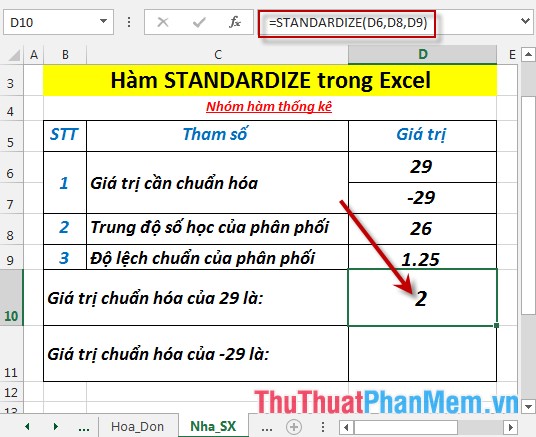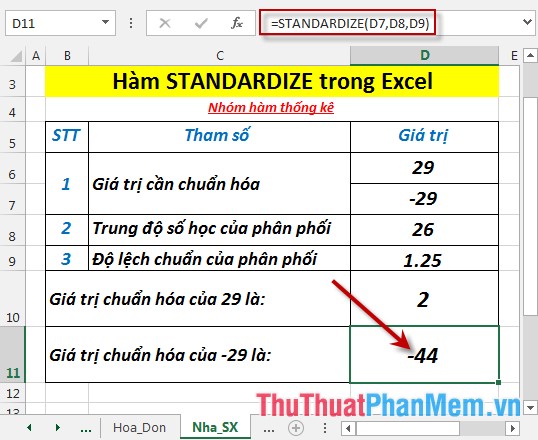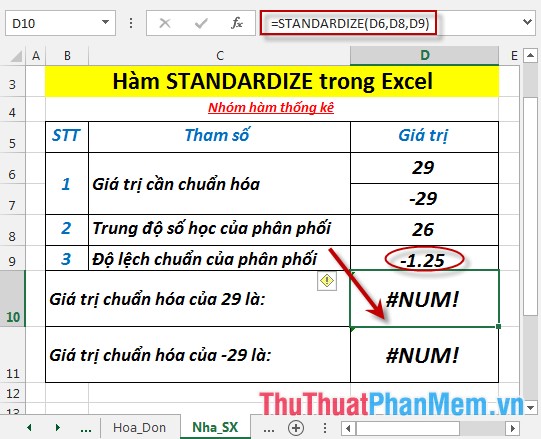STANDARDIZE function - The function returns the normalized value from a specific distribution in Excel
The following article introduces you to the STANDARDIZE function - one of the functions in the statistical function group is very popular in Excel.

Description: The function returns the normalized value from a distribution characterized by mean and standard_dev arguments.
Syntax: STANDARDIZE (x, mean, standard_dev)
Inside:
- x : The value you want to normalize, is a required parameter.
- mean: Arithmetic mean of distribution, is a required parameter.
- standard_dev: The standard deviation of the distribution, is a required parameter.
Attention:
- If standard_dev ≤ 0 -> the function returns the #NUM! Error value
- The equation for the normalized value is:
[Z = frac {{X - mu}} {sigma}]
For example:
Calculate the normalized value of the values in the following data table:

- Calculate the standardized value of 29 . In a cell to calculate, enter the formula : = STANDARDIZE (D6, D8, D9)

- Press Enter -> normalized value of 29 is :

- Calculate the normalized value of -29. In the cell to calculate enter the formula: = STANDARDIZE (D7, D8, D9) -> press Enter -> The normalized value of -29 is:

- Where the standard deviation of the distribution is less than or equal to 0 -> the function returns the #NUM! Error value

Above are instructions and some specific examples when using the STANDARDIZE function in Excel.
Good luck!
You should read it
- NORM.S.INV function - The function returns the inverse of the normalized distribution with an average value of 0 and a standard deviation of 1 in Excel
- POISSON.DIST function - The function returns the Poisson distribution in Excel
- POISSON function - The function returns the Poisson distribution in Excel
- GUSSE function - The function returns the probability that an element of the population is normalized in Excel
- WEIBULL function - The function returns the Weibull distribution in Excel
- GAMMA.INV function - The function returns the inverse of the gamma distribution in Excel
 STDEV.P function - The function returns the standard deviation based on the whole in Excel
STDEV.P function - The function returns the standard deviation based on the whole in Excel STDEV.S function - The function returns the standard deviation based on a sample in Excel
STDEV.S function - The function returns the standard deviation based on a sample in Excel GAMMA.INV function - The function returns the inverse of the gamma distribution in Excel
GAMMA.INV function - The function returns the inverse of the gamma distribution in Excel GAMMALN function - The function returns the natural logarithm of the gamma function, Γ (x) in Excel
GAMMALN function - The function returns the natural logarithm of the gamma function, Γ (x) in Excel GAMMALN.PRECISE function - The function returns the natural logarithm of the gamma function, Γ (x) in Excel
GAMMALN.PRECISE function - The function returns the natural logarithm of the gamma function, Γ (x) in Excel GEOMEAN function - The function returns the average of a positive array or range of data in Excel
GEOMEAN function - The function returns the average of a positive array or range of data in Excel